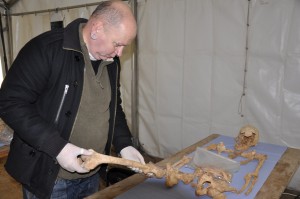By Helen King (W&M Regular Contributor)
How do you like your history on television? Do you like to hear from ‘talking heads’, or would you rather see a docudrama recreating a scene from the past? Do you get a bit fed up with the standard scene in which the presenter turns up at a museum or a library to ‘meet’ the expert who just happens to be hanging around there surrounded by conveniently relevant artifacts?
I made several brief appearances on TV last year. My favourite was on BBC’s History Cold Case. The case was a Romano-British woman who was buried with three newborn babies – two of which, the DNA eventually showed, were definitely her children. We couldn’t be certain about the third.
My role, as ‘expert’, was to talk to the presenter about how difficult births were handled in earlier historical periods, using ancient Greek texts that were known in the Roman world, but also analogies with 18th c methods. That part was filmed at the Royal College of Obst and Gyn. The production company was looking for a venue, and I have worked with the Library there before and knew that they are keen to participate in programmes like this. The Library staff did us proud – they produced various worrying devices from their historical collection, with a fine array of hooks and so on, as well as rare books on how such devices were used in the 18th century. The production company wanted to film a section with the ‘expert’ saying ‘And if you come this way, there’s something I think you’d like…’ I had no idea what to offer for this section, but the RCOG turns out to have some wonderful 16th c books which even showed the position of triplets in the womb. So, we filmed that – the best bit, I reckoned, as it showed exactly the same positions as the 21st c expert obstetrician talked about later in the programme – but it was lost on the cutting room floor! My second appearance in this programme was in a cold field in Baldock, where the skeletal remains were displayed in a tent while the forensic team talked through their conclusions. Most worrying moment – a close tie between a local dog getting in and expressing an interest in the bones, and a member of the local Archaeological Society swishing her coat against the table and knocking the foot bones on to the floor. Gasps of horror until they were put back in place!
There was something very moving and exciting about being in the presence of the skeletons of the woman and her babies after discussing them in the abstract. All credit to the archaeologists who had realised these tiny bones could be part of a baby. Part of the show’s format is a facial reconstruction, and like the members of the local archaeological society who were present I had not seen this until it was projected on a screen in the tent. My dropped jaw was genuine! I felt I had learned a lot. That’s when doing TV is really fun!

